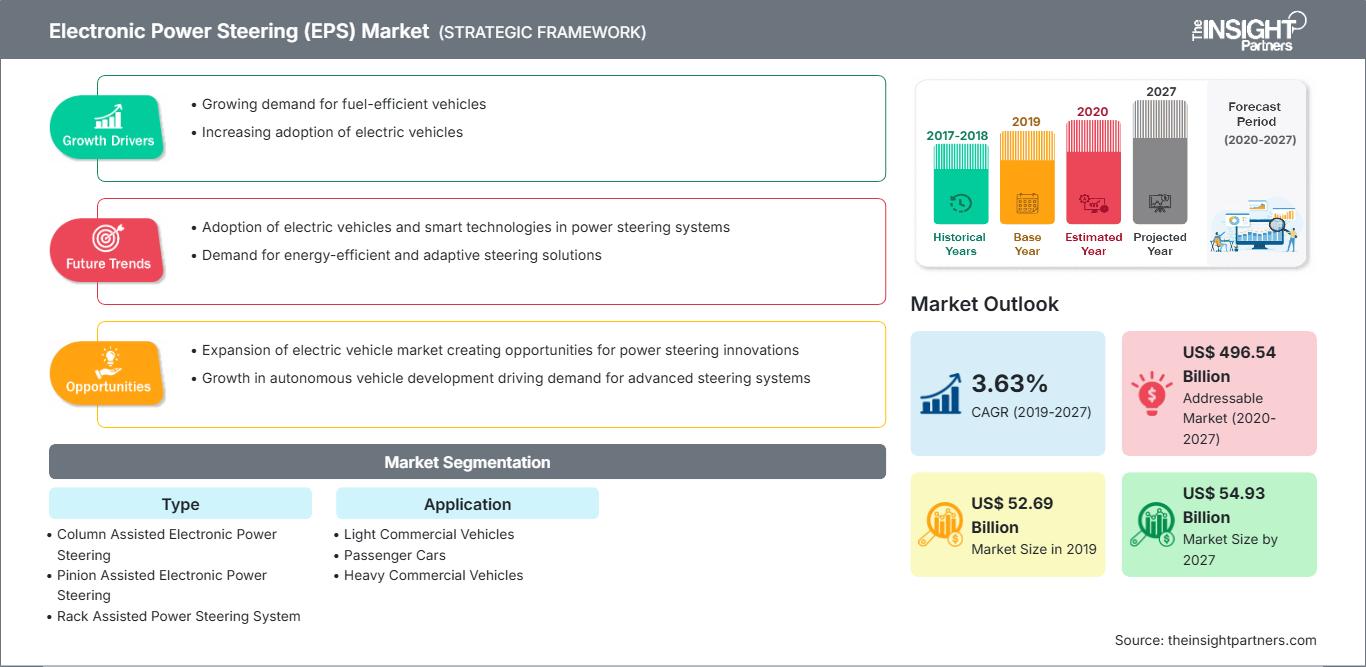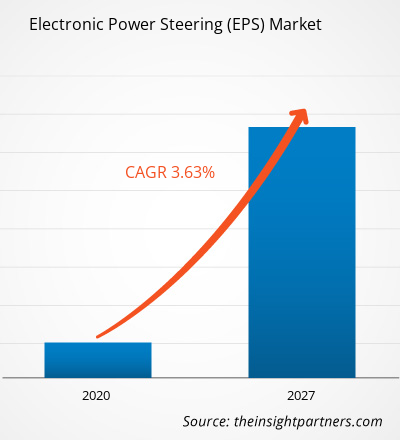Der globale Markt für elektronische Servolenkungen wurde 2019 auf 52.692,31 Millionen US-Dollar geschätzt und soll im Prognosezeitraum von 2020 bis 2027 mit einer durchschnittlichen jährlichen Wachstumsrate von 3,63 % wachsen.
Der Markt für elektronische Servolenkungen ist grob in fünf Hauptregionen unterteilt: Nordamerika, Europa, APAC, MEA und SAM. Der globale Markt wurde 2019 von der APAC-Region dominiert, die aufgrund der höheren Nachfrage nach elektronischen Servolenkungen fast die Hälfte des Gesamtmarktes ausmachte. Faktoren wie die stärkere Verbreitung von Premiumautos, Limousinen und SUVs in der APAC-Bevölkerung tragen erheblich zum größeren Marktanteil der Region bei. Zu den namhaften Nutzfahrzeugherstellern des Landes zählen Ford Motor Company of Australia Limited, Toyota Motor Corporation Australia Limited, Mitsubishi Motors Australia Ltd. (MMAL), General Motors Holden, Isuzu Australia Limited, Volkswagen Group Australia Pty Ltd. und Hyundai Commercial Vehicles Australia. Alle diese Hersteller fordern die Integration von EPS in ihre Fahrzeuge, um der steigenden Kundennachfrage gerecht zu werden. Darüber hinaus wird erwartet, dass die zunehmende Automobilproduktion, die steigende Nachfrage nach Elektrofahrzeugen und die zunehmende Konzentration der EPS-Hersteller auf kostengünstige und hocheffiziente Produkte das Wachstum des EPS-Marktes in den übrigen APAC-Ländern im Prognosezeitraum vorantreiben werden.
Markteinblicke – Markt für elektronische Servolenkung: Steigende Umsätze bei Premiumfahrzeugen in China
Passen Sie diesen Bericht Ihren Anforderungen an
Sie erhalten kostenlos Anpassungen an jedem Bericht, einschließlich Teilen dieses Berichts oder einer Analyse auf Länderebene, eines Excel-Datenpakets sowie tolle Angebote und Rabatte für Start-ups und Universitäten.
Markt für elektronische Servolenkungen (EPS): Strategische Einblicke

-
Holen Sie sich die wichtigsten Markttrends aus diesem Bericht.Dieses KOSTENLOSE Beispiel umfasst Datenanalysen, die von Markttrends bis hin zu Schätzungen und Prognosen reichen.
Im Jahr 2019 wurden in China fast 21,4 Millionen Fahrzeuge abgesetzt. Das Land ist der weltweit größte Autoproduzent und -absatzmarkt. Dennoch gingen die Gesamtabsätze im Jahr 2019 um etwa 1,9 % zurück, aber die Nachfrage nach SUVs und Premiumlimousinen stieg im Vergleich zu 2018 um 3,5 % bzw. 18,8 %. Alle großen OEMs von Luxusfahrzeugen im Land, darunter BMW, Mercedes-Benz und Audi, meldeten im November 2019 positive Zahlen. Mit dem Anstieg der Verkaufszahlen änderte sich auch das Marktszenario rapide. Frühere Generationen kauften Premiumfahrzeuge hauptsächlich, um ihren sozialen Status zu zeigen, aber die zunehmend anspruchsvollere neue Käufergeneration kauft Premiumautos, weil sie Luxus und clevere Technologien benötigen. Einer Studie der China Association of Automobile Manufacturers zufolge spielen Frauen auf dem chinesischen Premiumautomarkt eine bedeutende Rolle. Diese Umfrage ergab, dass Frauen bei der Wahl eines Fahrzeugmodells Sicherheitsmerkmale, Komfort und Außendesign höher bewerten als die von ihren Männern bevorzugten Eigenschaften wie Antriebstechnologie, gesellschaftlich anerkannte Premiummarken und größere Modelle. Die oben genannten Faktoren werden die Nachfrage nach der Integration von EPS in Limousinen und SUVs ankurbeln.
Auswirkungen von COVID-19
Die Halbleiter- und Automobilindustrie gehören zu den Opfern von COVID-19 und seit Anfang 2020 verzeichnen diese Branchen einen Abwärtstrend. Mit der Verhängung von Ausgangssperren in Ländern Nordamerikas, Europas und Asiens mussten diese Branchen erschütternde Erfahrungen machen. Die Automobilindustrie benötigt eine beträchtliche Menge menschlicher Arbeitskraft, und im Gegenteil, das COVID-19-Virus verbreitet sich durch menschliches Engagement, sodass der Sektor nicht richtig funktionieren kann. Der Abwärtstrend in der Automobil- und Halbleiterindustrie wirkt sich negativ auf den Markt für elektronische Servolenkungen aus.
Einblicke in Typensegmente
Nach Typen betrachtet dominierte das Segment der elektronischen Servolenkungen mit Lenkradunterstützung 2019 den globalen Markt für elektronische Servolenkungen. Elektronische Servolenkungen ersetzen in modernen Fahrzeugen nach und nach herkömmliche Lenksysteme. Der Hauptvorteil elektronischer Servolenkungen besteht in der Minimierung des Energieverbrauchs. Die elektronische Servolenkung mit Lenkradunterstützung (C-EPS) ist eine Art elektronischer Servolenkung.
Einblicke in Fahrzeugtypensegmente
Nach Fahrzeugtypen betrachtet hatte das Segment Pkw 2019 den größten Anteil am globalen Markt für elektronische Servolenkungen. Pkw sind Transportfahrzeuge mit nicht mehr als acht Sitzen. Aufgrund der sich verschlechternden Wetter- und Luftqualität in Ländern wie Bangladesch, Pakistan, der Mongolei, Afghanistan und Indien steigen die Menschen in ihren Pkw auf alternative Kraftstoffe und verwandte Technologien um. Pkw lassen sich in Limousinen, Fließhecklimousinen und SUVs bzw. MUVs unterteilen. Die Nachfrage nach Personenkraftwagen steigt mit dem Anstieg des Pro-Kopf-Einkommens und dem Bedürfnis nach Luxus.
Die Marktteilnehmer konzentrieren sich auf Produktinnovationen und -entwicklungen, indem sie fortschrittliche Technologien und Funktionen in ihre Produkte integrieren, um mit der Konkurrenz mithalten zu können.
- 2019 hatte Nexteer Automotive seinen Produktionsmeilenstein von 60 Millionen elektrischen Servolenkungen (EPS) weltweit bekannt gegeben. Diese könnten in Fahrzeugen vom Kleinwagen bis zum großen LKW zum Einsatz kommen. Die elektrischen Servolenkungen senken die Kraftstoffeffizienz um 6 % und die CO2-Emissionen um 8 Gramm pro Kilometer.
- 2018 hatte die Robert Bosch GmbH Autobahnassistenzsysteme von Bosch für teilautomatisiertes Fahren in alle Fahrzeuge der Maserati-Reihe des Modelljahres 2018 eingebaut. Darüber hinaus trägt die elektrische Servolenkung (EPS) von Bosch, eine weitere Innovation der Maserati-Modellreihe MY2018, zur Implementierung der Autobahnassistenztechnologie und anderer fortschrittlicher Fahrassistenzsysteme bei.
- Im Jahr 2018 hat Hyundai Mobis eine elektrische Servolenkung entwickelt, die beim autonomen Fahren zwei elektronische Schaltkreise nutzt, um unter allen Umständen die normale Lenkfähigkeit aufrechtzuerhalten.
Elektronische Servolenkung
Regionale Einblicke in den Markt für elektronische Servolenkungen (EPS)Die Analysten von The Insight Partners haben die regionalen Trends und Faktoren, die den Markt für elektronische Servolenkungen (EPS) im Prognosezeitraum beeinflussen, ausführlich erläutert. In diesem Abschnitt werden auch die Marktsegmente und die geografische Lage in Nordamerika, Europa, im asiatisch-pazifischen Raum, im Nahen Osten und Afrika sowie in Süd- und Mittelamerika erörtert.
Umfang des Marktberichts zur elektronischen Servolenkung (EPS)
| Berichtsattribut | Einzelheiten |
|---|---|
| Marktgröße in 2019 | US$ 52.69 Billion |
| Marktgröße nach 2027 | US$ 54.93 Billion |
| Globale CAGR (2019 - 2027) | 3.63% |
| Historische Daten | 2017-2018 |
| Prognosezeitraum | 2020-2027 |
| Abgedeckte Segmente |
By Typ
|
| Abgedeckte Regionen und Länder |
Nordamerika
|
| Marktführer und wichtige Unternehmensprofile |
|
Dichte der Marktteilnehmer für elektronische Servolenkungen (EPS): Verständnis ihrer Auswirkungen auf die Geschäftsdynamik
Der Markt für elektronische Servolenkungen (EPS) wächst rasant. Die steigende Nachfrage der Endverbraucher ist auf Faktoren wie veränderte Verbraucherpräferenzen, technologische Fortschritte und ein stärkeres Bewusstsein für die Produktvorteile zurückzuführen. Mit der steigenden Nachfrage erweitern Unternehmen ihr Angebot, entwickeln Innovationen, um den Bedürfnissen der Verbraucher gerecht zu werden, und nutzen neue Trends, was das Marktwachstum weiter ankurbelt.

- Holen Sie sich die Markt für elektronische Servolenkungen (EPS) Übersicht der wichtigsten Akteure
- Lenkradunterstützte elektronische Servolenkung
- Ritzelunterstützte elektronische Servolenkung
- Zahnstangenunterstütztes Servolenkungssystem
- Elektronische hydraulische Servolenkung
Markt für elektronische Servolenkungen – Nach Fahrzeugtyp
- Leichte Nutzfahrzeuge
- Pkw
- Schwere Nutzfahrzeuge
Markt für elektronische Servolenkungen – nach Region
-
Nordamerika
- USA
- Kanada
- Mexiko
-
Europa
- Frankreich
- Deutschland
- Italien
- Großbritannien
- Russland
- Übriges Europa
-
Asien-Pazifik (APAC)
- China
- Indien
- Südkorea
- Japan
- Australien
- Übriger APAC
-
Naher Osten und Afrika (MEA)
- Südafrika
- Saudi-Arabien
- VAE
- Rest von MEA
-
Südamerika (SAM)
- Brasilien
- Argentinien
- Rest von SAM
Markt für elektronische Servolenkungen – Firmenprofile
- Hyundai Mobis
- JTEKT Corporation
- Mitsubishi Electric Corporation
- Nexteer Automotive
- NSK Ltd.
- Robert Bosch GmbH
- Showa Corporation
- The Mando Corporation
- ThyssenKrupp AG
- ZF Friedrichshafen AG
- Historische Analyse (2 Jahre), Basisjahr, Prognose (7 Jahre) mit CAGR
- PEST- und SWOT-Analyse
- Marktgröße Wert/Volumen – Global, Regional, Land
- Branchen- und Wettbewerbslandschaft
- Excel-Datensatz
Aktuelle Berichte
Erfahrungsberichte
Grund zum Kauf
- Fundierte Entscheidungsfindung
- Marktdynamik verstehen
- Wettbewerbsanalyse
- Kundeneinblicke
- Marktprognosen
- Risikominimierung
- Strategische Planung
- Investitionsbegründung
- Identifizierung neuer Märkte
- Verbesserung von Marketingstrategien
- Steigerung der Betriebseffizienz
- Anpassung an regulatorische Trends






















 Kostenlose Probe anfordern für - Markt für elektronische Servolenkungen (EPS)
Kostenlose Probe anfordern für - Markt für elektronische Servolenkungen (EPS)